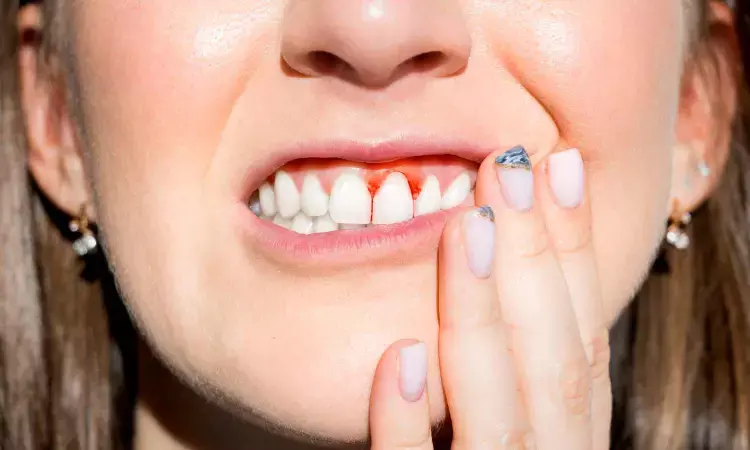- Home
- Medical news & Guidelines
- Anesthesiology
- Cardiology and CTVS
- Critical Care
- Dentistry
- Dermatology
- Diabetes and Endocrinology
- ENT
- Gastroenterology
- Medicine
- Nephrology
- Neurology
- Obstretics-Gynaecology
- Oncology
- Ophthalmology
- Orthopaedics
- Pediatrics-Neonatology
- Psychiatry
- Pulmonology
- Radiology
- Surgery
- Urology
- Laboratory Medicine
- Diet
- Nursing
- Paramedical
- Physiotherapy
- Health news
- Fact Check
- Bone Health Fact Check
- Brain Health Fact Check
- Cancer Related Fact Check
- Child Care Fact Check
- Dental and oral health fact check
- Diabetes and metabolic health fact check
- Diet and Nutrition Fact Check
- Eye and ENT Care Fact Check
- Fitness fact check
- Gut health fact check
- Heart health fact check
- Kidney health fact check
- Medical education fact check
- Men's health fact check
- Respiratory fact check
- Skin and hair care fact check
- Vaccine and Immunization fact check
- Women's health fact check
- AYUSH
- State News
- Andaman and Nicobar Islands
- Andhra Pradesh
- Arunachal Pradesh
- Assam
- Bihar
- Chandigarh
- Chattisgarh
- Dadra and Nagar Haveli
- Daman and Diu
- Delhi
- Goa
- Gujarat
- Haryana
- Himachal Pradesh
- Jammu & Kashmir
- Jharkhand
- Karnataka
- Kerala
- Ladakh
- Lakshadweep
- Madhya Pradesh
- Maharashtra
- Manipur
- Meghalaya
- Mizoram
- Nagaland
- Odisha
- Puducherry
- Punjab
- Rajasthan
- Sikkim
- Tamil Nadu
- Telangana
- Tripura
- Uttar Pradesh
- Uttrakhand
- West Bengal
- Medical Education
- Industry
Gum disease associated with changes in the brain, reveals research

Adults with gum disease may be more likely to have signs of damage to the brain's white matter, called white matter hyperintensities, than people without gum disease, according to a new study published on October 22, 2025, in Neurology® Open Access, an official journal of the American Academy of Neurology.
White matter refers to nerve fibers that help different parts of the brain communicate. Damage to this tissue can affect memory, thinking, balance and coordination and has been linked to higher stroke risk.
White matter hyperintensities are bright spots that appear on brain scans that are thought to reflect damaged white matter tissue. While the study found an association, it does not prove that gum disease causes white matter damage.
“This study shows a link between gum disease and white matter hyperintensities suggesting oral health may play a role in brain health that we are only beginning to understand,” said study author Souvik Sen, MD, MS, MPH, of the University of South Carolina in Columbia. “While more research is needed to understand this relationship, these findings add to growing evidence that keeping your mouth healthy may support a healthier brain.”
The study included 1,143 adults with an average age of 77. Each person had a dental exam to check for gum disease. Of participants, 800 had gum disease and 343 did not.
Participants had brain scans to look for signs of cerebral small vessel disease, which is damage in the brain’s small blood vessels that can appear as white matter hyperintensities, cerebral microbleeds or lacunar infarcts. These brain changes become more common with age and are associated with increased risk of stroke, memory problems and mobility issues.
People with gum disease had more white matter hyperintensities, with an average volume of 2.83% of total brain volume compared to 2.52% for people without gum disease.
Researchers divided people into four groups based on white matter hyperintensity volume. Those in the highest group had a volume of more than 21.36 centimeters cubed (cm³) while those in the lowest group had a volume of less than 6.41 cm³.
Of people with gum disease, 28% were in the highest group compared to 19% of people without gum disease.
After adjusting for factors such as age, sex, race, high blood pressure, diabetes and smoking, people with gum disease had 56% higher odds of falling into the highest group of white matter hyperintensities than people without gum disease.
However, no links were found between gum disease and two other brain changes tied to small vessel disease, cerebral microbleeds and lacunar infarcts.
“Gum disease is preventable and treatable,” said Sen. “If future studies confirm this link, it could offer a new avenue for reducing cerebral small vessel disease by targeting oral inflammation. For now, it underscores how dental care may support long-term brain health.”A limitation of the study is that brain imaging and dental assessments were conducted only once, making it difficult to assess changes over time.
Reference:
Meyer, J., et al. (2025). Periodontal Disease Independently Associated With White Matter Hyperintensity Volume. Neurology® Open Access. doi.org/10.1212/wn9.0000000000000037
Dr Kamal Kant Kohli-MBBS, DTCD- a chest specialist with more than 30 years of practice and a flair for writing clinical articles, Dr Kamal Kant Kohli joined Medical Dialogues as a Chief Editor of Medical News. Besides writing articles, as an editor, he proofreads and verifies all the medical content published on Medical Dialogues including those coming from journals, studies,medical conferences,guidelines etc. Email: drkohli@medicaldialogues.in. Contact no. 011-43720751


